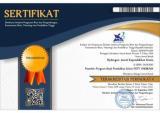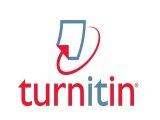Upaya Menurunkan Kadar Ion Logam Besi Pada Air Sumur Dengan Memanfaatkan Arang Ampas Tebu
DOI:
https://doi.org/10.33394/hjkk.v5i2.1590Keywords:
Iron metal ion, Adsorption, Sugar CaneAbstract
causing the yellow color on the walls of the bathroom tub and the yellow
spots on the clothes. One way of water treatment is by adsorption technique
using charcoal from bagasse. The first step is to first determine the level of
iron metal ions in the well water in the village of Palempat, Batulayar
District, West Lombok. Furthermore, the well water is contacted with sugar
cane bagasse. The manufacture of amphibians includes the sample
preparation process, wash with water, drying in the sun, and the refining at
250ºC for 2.5 hours then sieved. The sugarcane bagasse that has been put
into 100mLsampelair well with a mass of 2 grams of adsorbent. Samples were
then stirred at contact time variations of 30, 60, 90, 120 and 150 minutes at
180 rpm using a batch system. The best contact time used to calculate the
efficiency of decreasing iron metal ion content is by calculating the difference
of iron metal ions before adsorption and after adsorption using charcoal of
bagasse. From the research, it was found that iron metal ion content in the
sample was 0.1683 ppm. The optimum contact time on iron metal ion
adsorption is at 120 minutes contact resulting in optimum adsorption
efficiency in iron metal that is 65.83%.
References
Adamson, A.W. 1990. Physical Chemistry of Surface. 5th ed. John Willey & Sons: New
York.
Al-Asheh, S., F. Banat., R. Al Omari and Z. Duvnjak. 2000. Prediction of Binary Sorption
Isotherm for The Sorption of Heavy Metal by Pine bark Using Single Isotherm Data.
Chemosphore. Vol 41 : 659-665.
Atkin, P.W. 1986. Physical Chemistry. 3rd ed. Oxford University Press: Oxford.
Apriliani. 2010. Pemanfaatan Arang dari Ampas Tebu Sebagai Adsorben Ion Logam Cd, Cr,
Cu, dan Pb dalam Air Limbah. Skripsi. Jakarta : Universitas Islam Negeri Syarif
Hidayatullah.
Birowo, A.T. 1992. Seri Manajemen Usaha Perkebunan Gula, Edisi Pertama. Jogjakarta :
LPP
Darmono. 2008. Lingkungan Hidup dan Pencemaran. Jakarta : Universitas Indonesia Press.
http://www.kemendagri.go.id/pages/profil-daerah/kabupaten/id/52/name/nusa-tenggarabarat/
detail/5201/lombok-barat. Diakses pada 10 Februari 2017
Kaur S., Walia T.P.S., and Mahajan R.K. 2008. Comparative Studies of Zink, Cadmium,
Lead, and Copper on Economically Viable Adsorbents. Journal Environ. Eng. Sci. 7 :
-8.
Manocha, S. M. 2013. Porous Carbons. Jurnal Sadhana. Vol. 28, part 1 dan 2.
Material Handbook Thirteenth Edition, 1991.
Moore, W.J. 1995. Physical Chemistry, 2nd ed. Prentice-Hall Inc: Great Britain.
Oscik. 1982. Adsorption, 1st ed. Ellis Howard Limited Chicester. England.
Osipow, L.I. 1962. Surface Chemistry : Theory and Industrial Application. Reinhold
Publishing Coorporation: New York.
Rahman,A.H.B. 2004. “Penyaringan Air Tanah dengan Zeolit Alami untuk Menurunkan
Kadar Besi dan Manganâ€. Jurnal MAKARA. Vol.8, hlm. 1-6.
Roto, R., Dahlia R. I., dan Agus, K. 2015. Hydrotalsit Zn-Al-EDTA Sebagai Adsorben Untuk
Polutan Ion Pb (II) di Lingkungan. Jurnal Manusia dan Lingkungan. Vol. 22 (2) :
-232.
Santosa,S.J., Jumina dan Sri S. 2003. Sintesis Membran Bio Urai Selulosa Asetat dan
Adsorben Super Karboksimetilselulosa dari Selulosa Ampas Tebu Limbah Pabrik
Gula. Jogjakarta : FMIPA UGM.
Selvi, K., Pattabhi S and Kardivelu K. 2001. Removal of Cr(VI) from Aqueous Solution by
Adsorption Onto Activated Carbon. Bioresour Technol. Vol 80 : 87-89.
Stum, W. Dan Morgan, J.J. 1996. Aquatic Chemistry : Chemical Equilibria and Rates in
Natural Water. 3rd ed. John Willey & Sson, Inc: New York
Sulistyawati, S. 2008. Modifikasi Tongkol Jagung Sebagai Adsorben Logam Berat Pb (II).
Skripsi. Bogor : FMIPA IPB.
Gultom, Togu. 2006. Pengantar Enzimologi. Yogyakarta: FMIPA Universitas Negeri
Yogyakarta.
Kennedy dan Cabral. 1982. Biotechnology. Jerman: VCH.
Lehninger,A.L. 1994. Dasar-Dasar Biokimia. Jakarta: Erlangga.
Sirisansaneeyakul, S.,S. Jitbanjongkit., N. Prasomsart., P. Luangpituksa. 2000.
Production of-Fructofuranosidase from Aspergillus niger ATCC 20611.
KasetsartJournal (Natural Sciences), 34: 378-386.
Slominski,B.A.2006.Hydrolysisofgalaktooligosaccharides bycommercial preparations of
alpha-galactosidase and beta-fructofuranosidase: potential for use as dietaryadditives.
J.Sci. FoodAgric., 65(3), 323-330.
Triantarti, HerayatiE.M, ArisToharisman, danAgustin KrisnaW. 2011. Imobilisasi
Invertase DalamSel Basah Aspergillus Niger Inv-2 ISRI dengan Ikatan Silang
Menggunakan Glutaraldehid.MPG,47 (2): 109-118.
Wijayanti, Murniagus. 2007. Penggunaan Karbon Aktif Sebagai Bahan Pengamobi lEnzim
α-Amilase dan Karakterisasinya. Skripsi. UniversitasNegeri Yogyakarta.
Downloads
How to Cite
Issue
Section
Citation Check
License
License and Publishing Agreement
In submitting the manuscript to the journal, the authors certify that:
- They are authorized by their co-authors to enter into these arrangements.
- The work described has not been formally published before, except in the form of an abstract or as part of a published lecture, review, thesis, or overlay journal.
- That it is not under consideration for publication elsewhere,
- That its publication has been approved by all the author(s) and by the responsible authorities – tacitly or explicitly – of the institutes where the work has been carried out.
- They secure the right to reproduce any material that has already been published or copyrighted elsewhere.
- They agree to the following license and publishing agreement.
Copyright
Authors who publish with Hydrogen: Jurnal Kependidikan Kimia agree to the following terms:
- Authors retain copyright and grant the journal right of first publication with the work simultaneously licensed under a Creative Commons Attribution License (CC BY-SA 4.0) that allows others to share the work with an acknowledgment of the work's authorship and initial publication in this journal.Â
- Authors are able to enter into separate, additional contractual arrangements for the non-exclusive distribution of the journal's published version of the work (e.g., post it to an institutional repository or publish it in a book), with an acknowledgment of its initial publication in this journal.
- Authors are permitted and encouraged to post their work online (e.g., in institutional repositories or on their website) prior to and during the submission process, as it can lead to productive exchanges, as well as earlier and greater citation of published work.
Licensing for Data Publication
Hydrogen: Jurnal Kependidikan Kimia uses a variety of waivers and licenses, that are specifically designed for and appropriate for the treatment of data: Open Data Commons Attribution License, http://www.opendatacommons.org/licenses/by/1.0/ (default) Other data publishing licenses may be allowed as exceptions (subject to approval by the editor on a case-by-case basis) and should be justified with a written statement from the author, which will be published with the article.








